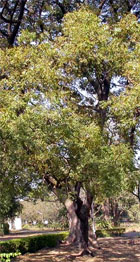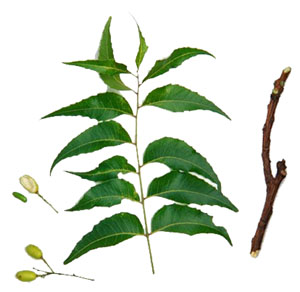Dec 22, 2025
Dec 22, 2025
 Neem which belongs to family Meliaceae, has a botanical name Azadirachta Indica. It grows in tropical and semi tropical regions and is widely found in Burma, India and Pakistan. This is a very fast growing, evergreen tree which reaches the height of 15 to 20 meters.
Neem which belongs to family Meliaceae, has a botanical name Azadirachta Indica. It grows in tropical and semi tropical regions and is widely found in Burma, India and Pakistan. This is a very fast growing, evergreen tree which reaches the height of 15 to 20 meters.
Neem is known for its immeasurable medicinal properties and is used as a main ingredient in many home remedies. Commending the medicinal properties of Neem, numerous Sanskrit names have been coined by our Ayurveda acharyas . Few of them are mentioned below.
Chemical composition of Neem
Neem tree has numerous medicinal properties by virtue of its chemical compounds. Seeds of the Neem tree contain the highest concentration of Azadirachtin. Apart from Azadirachtin, salannin, gedunin, azadirone, nimbin, nimbidine, nimbicidine, nimbinol, etc are other important liminoids of neem.
Uses of Neem in Horticulture
 Neem has been the most traditionally used plant in India , Pakistan and Africa to protect grains and cereals from pests. Fresh Neem leaves are mixed with grains and cereals before storing. A paste of fresh Neem leaves is rubbed against the wall of large mud bins or gunny bags in which the grains and cereals are stored. Some times a thick layer of dry Neem leaves are spread over grains. Neem oil extracted from seeds acts as best bio-pesticide. Jute sacks treated with Neem oil or extracts of Neem are used to store food grains. Neem oil is a very cheap and effective household pesticide to protect grains and legumes from pests. Neem is being used to protect stored roots and tubers from potato moth.
Neem has been the most traditionally used plant in India , Pakistan and Africa to protect grains and cereals from pests. Fresh Neem leaves are mixed with grains and cereals before storing. A paste of fresh Neem leaves is rubbed against the wall of large mud bins or gunny bags in which the grains and cereals are stored. Some times a thick layer of dry Neem leaves are spread over grains. Neem oil extracted from seeds acts as best bio-pesticide. Jute sacks treated with Neem oil or extracts of Neem are used to store food grains. Neem oil is a very cheap and effective household pesticide to protect grains and legumes from pests. Neem is being used to protect stored roots and tubers from potato moth.
Azadirachtin is available in high concentration in Neem seeds. It is used as 'botanical pesticide' which is environmentally friendly. It prevents insects from feeding on plants and regulates the growth of insects. Neem extracts do not harm the insects like bees, spiders and butterflies which help in pollination.
Medicinal Properties of Neem
The Neem tree has many medicinal uses. The chemical compounds present in Neem have anti-inflammatory, anti-arthritic, antipyretic, hypoglycaemic, anti-fungal, spermicidal, anti-malarial, anti-bacterial and Diuretic properties. Flower, leaves, bark and seeds of Neem are used in home remedies and in preparation of medicines. Bark of Neem acts as antipyretic and helps to reduce fever. Flowers are used in intestinal disorders. Juice from fresh leaves is very helpful in treating skin diseases, wounds and obesity. Oil from Neem seeds is used in arthritis, skin diseases and muscular sprains. Neem is very effective in treating gum diseases.
The Neem is proved to be beneficial in treating skin diseases because of its antibiotic, antifungal and blood purifying properties. According to Ayurveda principles vitiated Kapha and Pitta cause skin diseases. Neem pacifies vitiated kapha and pitta, thus helps to cure skin ailments. It promotes wound healing as it is antibacterial and astringent. In psoriasis it reduces itching, irritation, roughness of skin and heals the psoriatic patches. In same way it heals eczema too. It reduces infection and inflammation of acne. Neem helps to maintain the health of scalp skin and prevents dandruff.
Due to its detoxifying properties it helps to keep organ systems healthy, especially circulatory, digestive, respiratory and urinary systems.
Scientific studies have revealed that Neem reduces blood sugar level. Hence its usage supports diabetic patients to keep their blood sugar level in control. Diabetes impairs blood circulation and causes gangrene in lower extremities. Numerous scientific researches have highlighted the role of Neem in keeping circulatory system healthy, thus reducing the chances of gangrene. Recent studies have shown that Neem reduces blood cholesterol level and keeps the heart healthy.
Home remedies with Neem
Neem in Household
Neem flower pachidi is prepared from roasted Neem flower and is a famous dish in South India which is prepared during Ugadi. Neem flower rasam improves digestion and is very popular in Andhra and Tamilnadu.
Extract of skin friendly Neem is being used in manufacturing bathing soaps, hair gels, body lotions etc. These products are gaining popularity in market.
Dr. Savitha Suri B.A.M.S is Chief Consultant physician at Chaitanya Integrated Medical Center, Udayagiri, Mysore, Karnataka, India. She is practicing Indian Systems of Medicines since 12 years. By arrangement with http://www.ayurhelp.com
Disclaimer:
Information provided in this article is for the sole purpose of imparting education on Ayurveda and is not intended to diagnose, treat, cure or prevent any disease. If you have a medical condition, please consult your physician.
27-Jan-2007
More by : Dr. Savitha Suri